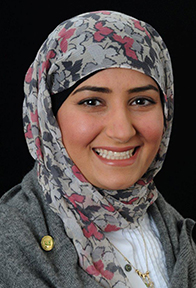Engineering Spotlight: Hanan Altabbakh
Engineering Spotlight: Hanan Altabbakh

Hanan Altabbakh is an engineering graduate student at Missouri University of Science and Technology in Rolla, MO working on her Ph.D. in Engineering Management with an emphasis on risk assessment. She holds a B.S. degree in Industrial and Management Systems Engineering from Kuwait University and a M.S. in Engineering Management from Missouri S&T.
“I chose industrial engineering and engineering management since both fields combine technical as well as managerial aspects of running an organization. It also prepares young engineers to be motivating leaders and successful decision makers as they are capable of managing various disciplines due to their acquired skills and knowledge during their education.”
Prior to starting her graduate academic journey, she worked for the Ministry of Education in Kuwait as a Safety Engineer.
Hanan’s current research is focused on applying various risk assessment tools and accident causation models to analyze accidents in sociotechnical systems. She credits Dr. Susan Murray, her advisor, for providing continuous guidance and support for all of her research and academic progress.
In her latest research paper with contributing authors Dr. Murray and Dr. Katie Grantham, she won first place in the 2012 ASME SERAD competition. ‘Towards Quantifying the Safety Cognition in the Undergraduate’, examines safety training exposure and knowledge within young engineers involved in engineering competition teams and potential causes that prevent young engineers from making appropriate decision from a safety prospective. “The research showed that young engineers have been receiving informal safety training, which is often ineffective, and do not always assure positive safety attitude or safety performance, which reflected in their attitude in school’s workshops or labs.”
When asked, about why engineers should care about [safety/risk analysis], Hanan said, “Considering both safety and risk assessment in different stages of any research or project it is essential to prevent accidents by designing for safer systems/products. In addition, identifying hazards and assessing risk at early stages, such as the conceptual stages, will definitely reduce, if not eliminate, undesired cost of adding safety controls as the system/product progress.”
In her experience, Hanan has discovered that every task and activity has a safety and risk analysis component and she strongly advocates that young engineers be exposed more to formal safety training and education within their undergraduate education. “I hope that safety education and training will be part of college education since these young engineers will be future managers and decision makers who will play a major role in establishing a safety climate within their organization. Hence, it will positively influence the employees’ safety performance.” Hanan’s ultimate goals as an engineer over the next few years will be to explore more risk assessment tools that can both analyze accidents causation and prevent them from happening in complex system that involve human, machines and environment.
Her advice for other early career engineers and students, “Don’t stop seeking knowledge after graduating from college; do more research and read what others have contributed to different fields. Try to participate in conferences and forums that enhance your skills. Try to keep yourself up to date with new ideas or technologies concerned with safety and risk assessment. Once you are part of an organization, always be prepared for a good change to achieve quality and don’t be an ‘Anchor dragger’. Safety is an essential part of the ultimate quality.”
.png?width=854&height=480&ext=.png)


